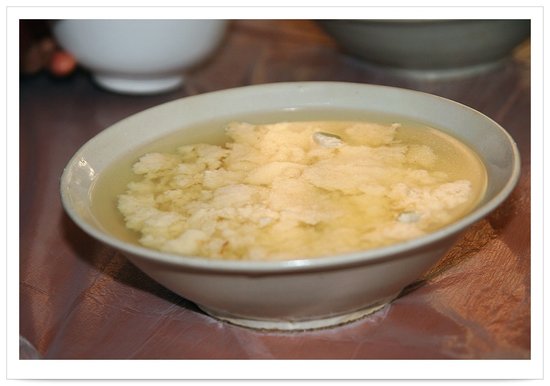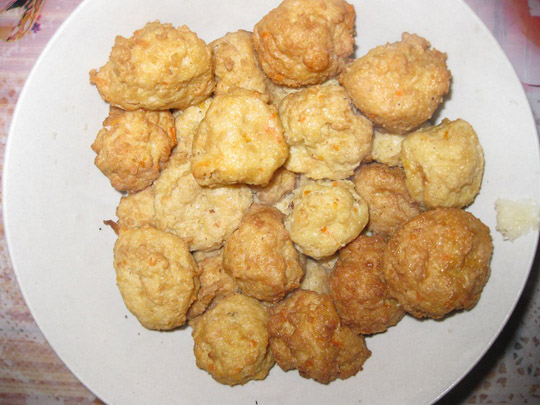
| What is Flavor and Fortune? |
| How do I subscribe? |
| How do I get past issues? |
| How do I advertise? |
| How do I contact the editor? |
Read 12777405 times
Connect me to:
| Home |
| Articles |
| Book reviews |
| Letters to the Editor |
| Newmans News and Notes |
| Recipes |
| Restaurant reviews |
| Article Index (all years, slow) |
| List of Article Years |
| Article Index (2025) |
| Article Index (last 2 years) |
| Things others say |
| Related Links |
| Log In... |
| Authors |
| Categories & Topics |
Bean Curd Balls for Cheng De's New Year
| by Wang Yuanguang |
Holidays and Celebrations
Spring Volume: 2013 Issue: 20(1) page(s): 5 - 6
 Bean curd is a very common food in China, one that is used in many ways. There are a number of methods to make it and many ways to use it, frying is just one way to use homemade bean curd. This article is about one doufu dish, the one I love the most.
My hometown is located in the Hebei Province, in the city of Cheng De. I have provided two maps, one to see where this province is, the other to see where Cheng De is in the province.
Bean curd is a very common food in China, one that is used in many ways. There are a number of methods to make it and many ways to use it, frying is just one way to use homemade bean curd. This article is about one doufu dish, the one I love the most.
My hometown is located in the Hebei Province, in the city of Cheng De. I have provided two maps, one to see where this province is, the other to see where Cheng De is in the province.
The Fried Bean Curd Balls there are a local traditional food very popular during Spring Festival, which is also known as Chinese New Year. This is one fried food we do not eat frequently, but this dish is popular during some important festivals including the above mentioned one, also at weddings, birthday celebrations of elders, and some other holidays.
On different occasions these bean curd balls are made in different quantities and in different sizes. This special food is not only delicious and loved at these times, but also at other times, too. This holiday dish has lots of meanings including wishing for a reunion, for riches, and for happiness. The weather during Spring Festival is still cold so we do not have many fresh colorful vegetables. Bean curd is a good substitute for vegetables, and it is a good side dish. In this cold weather, we eat more high-calorie foods, so recipes for these Fried Bean Curd Balls are welcome. They are nutrient-rich, caloric, and they taste terrific.
 There are many different methods to make bean curd balls, various ones have different tastes, different methods are used to make them, and they add different ingredients to the basic bean curd, which in Chinese is called doufu. The main material is, of course, bean curd made from ground soy beans. At holiday times, we usually use bean curd that we make ourselves, yes we make it with our own hands.
There are many different methods to make bean curd balls, various ones have different tastes, different methods are used to make them, and they add different ingredients to the basic bean curd, which in Chinese is called doufu. The main material is, of course, bean curd made from ground soy beans. At holiday times, we usually use bean curd that we make ourselves, yes we make it with our own hands.
The soybeans for these holiday treats are planted personally and organically, and they are non-transgenic. The seeds we use are old varieties that have been in our families for generations. This can mean they are low yielding, and that they require more labor.
HOLIDAY BEAN CURD means picking then selecting smooth and full beans, as are the ones shown here. Then we soak them in water until a little soft, then crush them. In the past, manual stone mills were used to crush the beans, but nowadays, nearly all have been replaced by machines that do the job. Next, we boil the soy beans and that liquid does look like soy bean milk, but it has lots of soy bean dregs in it. We do not eat these dregs, some people do feed them to their animals.
After boiling this, we filter the soy bean milk using specialized tools such as loosely woven gauze bags. The pure bean milk can get out and the bean dregs stay in these bags. Another tool used is a kneading board with many holes in it; this lets the pure bean milk flow through. We press the gauze bag on the kneading board. After this is done, we boil this and call it the second bean milk. Sometimes, at this point, we remove some of the milk to drink. After drinking some, it is time to coagulate the soy bean milk. We use brine to turn it into doufu or bean curd. We call this doufu nao or doufu hua, a jellied bean curd the brine made curdle. Then we use some heavy object to press the curds getting as much water out as possible. There are other coagulants that can be used instead of brine, and two come to mind. They are gypsum and citric acid; there are others.
Generally speaking, bean curd using brine as the coagulant is called 'north bean curd' while one using gypsum as its coagulant is called 'south bean curd.' The difference between them is that south bean curd is more tender than the one called north bean curd. As we need more firm bean curd to make fried bean curd balls, we make them with north bean curd. North bean curd breaks apart less when fried than does south bean curd.
There is a way to make them if you just have tender bean curd; that is to steam the bean curd first. Bean curd becomes more firm when steamed. Next, we press excess water out and shape the residue to become a block. This is the bean curd we now next.
MAKING BEAN CURD BALLS means crushing the firm beam curd while it is still warm. This is easier than when it is cold. The more pulpy it is, the better. We like to use our hands and feel it directly. We also prepare some auxiliary items to add to the mashed bean curd such as minced white radish and minced carrot. It is a good idea to scald these vegetables in boiling water to remove any aroma before adding them. This is particularly important for those who find their smell objectionable, particularly that of the radish. One can add other vegetables, and I suggest you be innovative when selecting them. Some people add meat at this point, but too much meat means the balls taste like meal balls. Eggs are indispensable, too, as they improve the taste while helping when the balls are formed and cooked. The number of eggs added is according to personal taste, just keep in mind that too many will replace the bean curd taste.
Now one needs to add some seasonings. Salt, chopped fresh ginger and garlic are good, scallions not recommended. A little pepper powder and soy sauce, are good, too. If the mashed bean curd is not sticky enough to form blocks, add a little starch as it will promote stickiness. Then, stir these raw materials and shape this mixture into balls, as can be seen in the picture here.
After shaping this mixture into balls, or while doing so, and after putting vegetable oil into a wok or a fry pan and heating it, reduce the heat and add the bean curd balls. It is not necessary to make them too hard when shaping them. They will turn a deeper yellow when fried, and their surface will be crisp when ready to take them out of the wok or pot and drain them of excess oil. Serve them in a bowl or on a plate I did here.
Now they are ready to be eaten. They will have a crisp surface and a tender interior. Their fragrance will fill nose and mouth, particularly when eaten right out of the pot. They will not be crisp and their fragrance will be reduced if not consumed immediately. One can make a sauce for them or put some into soup. Those ways they are also delicious.
These Fried Bean Curd Balls are just one of the indispensable foods adored during Spring Festival. They are a treat and are good food for all ages. As a symbol of good wishes for the future, there are many other foods eaten at the New Year's Eve Reunion Meal. Fish is one of them. It symbolizes surplus in the coming year. Chicken is another and it means good opportunity or change. Celery means diligence and hard work in the coming year, and garlic stems mean sagacious, earning money and keeping wealth in the New Year.
This special New Year’s meal is the nicest meal of the year. It is not only for family members who work hard all year, but also to celebrate achievements made in the past year. This holiday and its special foods offer wonderful wishes for the coming year.
_____
Wang Yanguang is a Master's degree candidate at Yunnan University in Kunming, China. She is majoring in anthropology. Her current studies concentrate on ecology, livelihoods, and sustainable development of women. She forwarded all of the pictures, some taken in her hometown, and advises other interests include community sport agriculture, eco-agriculture, organic foods, and traditional food technology.

Copyright © 1994-2025 by ISACC, all rights reserved
Address
3 Jefferson Ferry Drive
S. Setauket NY 11720